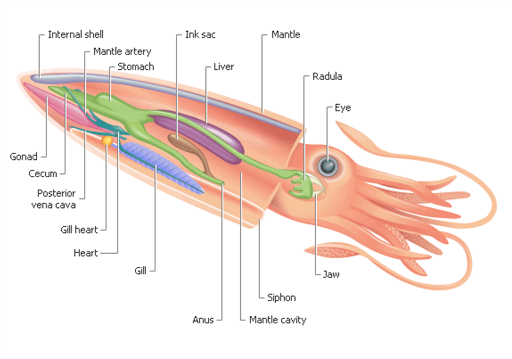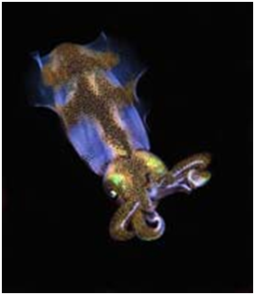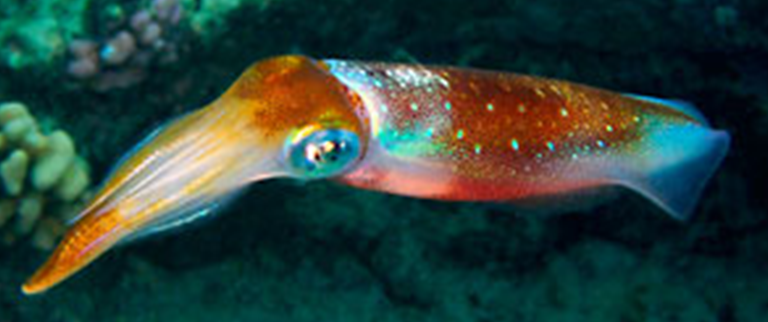What Makes Sepioteuthis
Lessoniana Unique??
Jet propulsion
Sepioteuthis lessoniana, more commonly known as Bigfin Reef Squids, are known for their incredibly fast reaction time in response to predators and dangerous stimuli. Sepioteuthis lessoniana have been known to get as fast as 15 meters per second! That is faster than Michael Phelps on a good racing day! This quick movement is made possible with the use of jet propulsion. In a nutshell jet propulsion is water being taken in and expelled forcefully under pressure. The main part of a squid is called a mantle, which a highly muscular organ which surrounds the entire body of the squid. When the mantle contracts it forces water through a tubular siphon called the hyponome. Sepioteuthis lessoniana can determine the direction in which it is propelled by pointing the siphon in the opposite direction of where it wants to go. When trying to escape predators (or going after prey of their own), the maximum rate of contraction was much higher in younger squids (7-13 muscle lengths per second) and slowly declined as the squid got older (3-5 muscle lengths per second). The younger squids are able to contract the mantle muscle so much faster than the larger, older ones because the fiber length of the muscle fibers are much shorter in smaller squid. These fibers are made up of two different muscle orientations. There are circular muscles and radial muscle fibers. The majority of the mantle is made up of the circular muscle fibers. These circular fibers are further broken down into three different zones; an outer zones, central zones and an inner zone.

Closed Circulatory System
Sepioteuthis lessoniana has a closed circulatory system with three hearts. A closed circulatory system allows the squid to move quickly to capture prey or to get out of a dangerous situation. In a closed circulatory system, blood is not free to flow everywhere. Instead it is contained within the blood vessels themselves. In other words the blood remains inside the capillaries, veins and arteries. Instead of the blood containing heme, the blood cells are composed of strictly of cells and plasma. The oxygen carrier in Cephalopod blood is actually hemocyanin, which is Copper based making the blood appear blue.
The squid has a total of three hearts. Sepioteuthis lessoniana have two brachial hearts (gill hearts) at the base of their gills. These are used to pump oxygen deficient blood through the gills where the CO2 in the blood is exchanged for oxygen and the CO2 is pumped out of the body through the siphon. The third hearts pumps oxygenated blood throughout the rest of the body.
Respiration
Water and Oxygen enter the squid's body through the mantle. Sepioteuthis lessoniana have gills, which is where oxygen and carbon dioxide are exchanged. Oxygen is carried from the gills around the body by the blood, while carbon dioxide is expelled through the siphon along with water.
Eyes
Sepioteuthis lessoniana and other squids have incredibly complex eyes. They are capable of focusing and forming clear images. The pupil in cephalopods is rectangular in shape and adjusts between a rectangular shape and a narrow slit (like a cat)When light enters the squids eye, the photoreceptors of the eye produce an action potential which is later sent to the brain where an image is seen. Squids have ciliary muscles that are used to draw the lens in and out in order to focus on different objects. If the object is far away (really far away) the lens is drawn in and if the object is close then the ciliary muscles relax. The eyes are well protected with a thick sclera (layers of cartilage) and two sheets of matrix.
Axon
Some researchers say that a Sepioteuthis lessoniana have the same thinking capabilities as a housecat. They are incredibly smart and have a giant axon, which makes the Sepioteuthis lessoniana an important animal in neurological studies.
Camouflage
Sepioteuthis lessoniana are able to hide in their surroundings very well. Some refer to squids as masters of disguise. Squids have pigmented skin cells that allow them to camouflage themselves almost instantly.
It has been shown in recent research that Sepioteuthis lessoniana may use different polarized skin patterns s a means of communication between different squids. This would allow for squids to communicate to each other while remaining camouflaged from predators.
Ink Sacs
Sepioteuthis lessoniana contain what is called an Ink Sac. When there are predators in the area, Sepioteuthis lessoniana will release a dark cloud of ink (called Sepia), blinding the enemy temporarily, so that the squid can get away using jet propulsion. The ink also has a very high pH to it. The alkalinity may help protect the squid in temporarily blocking the predator's sense of smell which also aids Sepioteuthis lessoniana escaping from danger!

©2009 Guido & Philippe Poppe - www.poppe-images.com
Lessoniana Unique??
Jet propulsion
Sepioteuthis lessoniana, more commonly known as Bigfin Reef Squids, are known for their incredibly fast reaction time in response to predators and dangerous stimuli. Sepioteuthis lessoniana have been known to get as fast as 15 meters per second! That is faster than Michael Phelps on a good racing day! This quick movement is made possible with the use of jet propulsion. In a nutshell jet propulsion is water being taken in and expelled forcefully under pressure. The main part of a squid is called a mantle, which a highly muscular organ which surrounds the entire body of the squid. When the mantle contracts it forces water through a tubular siphon called the hyponome. Sepioteuthis lessoniana can determine the direction in which it is propelled by pointing the siphon in the opposite direction of where it wants to go. When trying to escape predators (or going after prey of their own), the maximum rate of contraction was much higher in younger squids (7-13 muscle lengths per second) and slowly declined as the squid got older (3-5 muscle lengths per second). The younger squids are able to contract the mantle muscle so much faster than the larger, older ones because the fiber length of the muscle fibers are much shorter in smaller squid. These fibers are made up of two different muscle orientations. There are circular muscles and radial muscle fibers. The majority of the mantle is made up of the circular muscle fibers. These circular fibers are further broken down into three different zones; an outer zones, central zones and an inner zone.

Closed Circulatory System
Sepioteuthis lessoniana has a closed circulatory system with three hearts. A closed circulatory system allows the squid to move quickly to capture prey or to get out of a dangerous situation. In a closed circulatory system, blood is not free to flow everywhere. Instead it is contained within the blood vessels themselves. In other words the blood remains inside the capillaries, veins and arteries. Instead of the blood containing heme, the blood cells are composed of strictly of cells and plasma. The oxygen carrier in Cephalopod blood is actually hemocyanin, which is Copper based making the blood appear blue.
The squid has a total of three hearts. Sepioteuthis lessoniana have two brachial hearts (gill hearts) at the base of their gills. These are used to pump oxygen deficient blood through the gills where the CO2 in the blood is exchanged for oxygen and the CO2 is pumped out of the body through the siphon. The third hearts pumps oxygenated blood throughout the rest of the body.
Respiration
Water and Oxygen enter the squid's body through the mantle. Sepioteuthis lessoniana have gills, which is where oxygen and carbon dioxide are exchanged. Oxygen is carried from the gills around the body by the blood, while carbon dioxide is expelled through the siphon along with water.
Eyes
Sepioteuthis lessoniana and other squids have incredibly complex eyes. They are capable of focusing and forming clear images. The pupil in cephalopods is rectangular in shape and adjusts between a rectangular shape and a narrow slit (like a cat)When light enters the squids eye, the photoreceptors of the eye produce an action potential which is later sent to the brain where an image is seen. Squids have ciliary muscles that are used to draw the lens in and out in order to focus on different objects. If the object is far away (really far away) the lens is drawn in and if the object is close then the ciliary muscles relax. The eyes are well protected with a thick sclera (layers of cartilage) and two sheets of matrix.
Axon
Some researchers say that a Sepioteuthis lessoniana have the same thinking capabilities as a housecat. They are incredibly smart and have a giant axon, which makes the Sepioteuthis lessoniana an important animal in neurological studies.
Camouflage
Sepioteuthis lessoniana are able to hide in their surroundings very well. Some refer to squids as masters of disguise. Squids have pigmented skin cells that allow them to camouflage themselves almost instantly.
It has been shown in recent research that Sepioteuthis lessoniana may use different polarized skin patterns s a means of communication between different squids. This would allow for squids to communicate to each other while remaining camouflaged from predators.
Ink Sacs
Sepioteuthis lessoniana contain what is called an Ink Sac. When there are predators in the area, Sepioteuthis lessoniana will release a dark cloud of ink (called Sepia), blinding the enemy temporarily, so that the squid can get away using jet propulsion. The ink also has a very high pH to it. The alkalinity may help protect the squid in temporarily blocking the predator's sense of smell which also aids Sepioteuthis lessoniana escaping from danger!

©2009 Guido & Philippe Poppe - www.poppe-images.com
